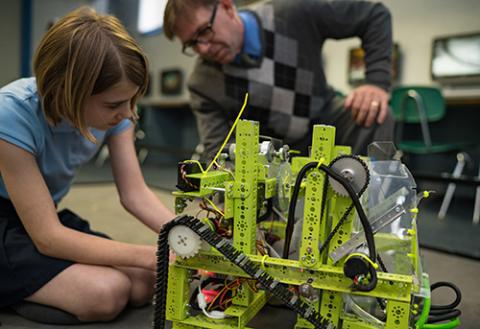
Written for the March 2017 edition of FAITH Grand Rapids magazine by Greg Ghering. Photography by Eric Tank. Pictured: St. Mary principal JB Watters helps a student work on a robot.
The sound of whirring gears in the classrooms at St. Mary Catholic School in Big Rapids makes it clear the students here are talented tinkerers. They’re busy building robots for the national FIRST Tech Challenge, but they’re learning far more than how to assemble and program their machines. Principal JB Watters is giving his students the knowledge to excel and the wisdom to use their knowledge to serve God.
JB finds God’s beauty in the technology that makes his students’ robots possible. “Math is a very logical thing, and faith isn’t,” he says. “In some ways, they oppose each other, but to me math and technology are so beautiful they wouldn’t have been created without having God there to guide them.”
Establishing and guiding the St. Mary robotics program is for JB a way of living his relationship with God in a subject area that seems at first like a surprising way to express faith. Watters sees the work of bringing his students from learning what they can do to determining what they should do as his God-given calling. The students, for instance, use their robotics tools to build prosthetic hands for children in need overseas.
“That’s where I think the faith part of it comes in for me,” he says. “It’s about why we should do this: I want our kids to be leaders in the technology field, but also to have that strong moral background to make moral decisions.”
A lifelong Catholic and a graduate of Catholic schools, JB attended St. John Vianney Catholic School in Wyoming, Mich., through eighth grade. During his high school years, his parents moved the family to mid-Michigan, where he graduated from Mount Pleasant Sacred Heart Academy. He studied education at Central Michigan University and became a high school math teacher. He’s been in education ever since, including 10 years running his own company selling educational software.
He first learned about school robotics programs when working in Virginia. His daughter, Ashley Rose, now a senior in high school, was in seventh grade; her school had a robotics program. When the family moved back to Michigan and JB became principal at St. Mary, he wanted to start robotics there, too, but there weren’t any other programs in the Big Rapids area for him to reference. Looking for someone to help him launch one, JB connected with a St. Mary school board member who’s a manufacturing engineering professor at Ferris State University. The professor asked his students for help; four volunteered and are
still mentoring St. Mary students four years later.
When he started the program, technology’s impact on society was part of the discussion and has remained so. “One of the parents said to me, ‘It’s scary how far technology has come.’ To me, that’s why we want people with a strong moral background making decisions, so it becomes not ‘What can we do?’, but ‘What should we do?’”
FIRST Robotics (an acronym for “For Inspiration and Recognition of Science and Technology”) is a weekly part of the curriculum for all St. Mary Catholic School first- through eighth-graders. The first-, second- and third-graders participate in FIRST LEGO League Jr., an introduction to robotics using the popular brand of toy bricks. In grades 4-6, students do FIRST LEGO League, putting small motors on LEGO creations and programming them with simple commands. Students in grades 7-8 compete against teams from other schools in FIRST Tech Challenge, building robots that fit within an 18-inch cube and controlling them to do things like throwing balls into a basket or hitting buttons to turn on different lights. The programs change each year and require students to build new machines capable of accomplishing new objectives.
JB includes the robotics program in the curriculum in order to provide students what he calls STREAM education, encompassing science, technology, engineering and math, as well as art and religion. “That’s one of the things we do here a lot: incorporate our faith into all of the subjects,” he says.
FIRST Robotics also has an educational component that goes beyond building robots. This year’s theme involves learning about how humans help animals and vice versa. For their project, students in fourth grade learned from the local animal shelter about feral cats and decided to create small, portable shelters for them. They raised funds, built a prototype and made a presentation about it.
“It ties in with what the pope has said about taking care of the earth and taking care of God’s creation,” JB says. “It ties in perfectly with faith.”
Faith also informs the way students use some of their robotics equipment for service: building prosthetic hands for the e-NABLE Project, an effort to provide prostheses to children in developing countries. St. Mary students make the devices with their 3-D printer, which they normally use to produce plastic parts for their robots. For the e-NABLE Project, they program it to build components for prostheses that they then assemble. The prostheses are sent to the City University of New York, where they’re wired and shipped to recipients.
St. Mary students have presented their robots in showcases at the state Capitol and have recruited other schools with 3-D printers to contribute to the e-NABLE Project, too. “It’s the whole reason why we do this: It’s not just to do it for technology or to be the best; it’s to help others,” he says. As gears whir in St. Mary classrooms, that perspective is precisely how JB’s faith powers his passion for high-tech teaching.
Learn more
Find more stories about how Catholic schools integrate faith and technology under the blog section at Catholicschools4u.org. Read about E-NABLE's "Helping Hand" projects at enablingthefuture.org.




